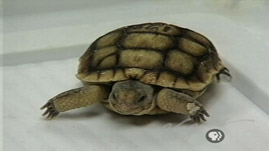Teachers' Domain - Digital Media for the Classroom and Professional Development
User: Preview

Source: “Outdoor Nevada”
This video segment from Outdoor Nevada investigates natural and man-made factors leading to the decline of the desert tortoise population. Find out what school children, scientists, and local residents are doing to help save this threatened species.
The desert tortoise, Gopherus agassizii, is a land-dwelling turtle that inhabits the Sonora and Mojave Deserts. This reptile has a brown, black, or gray dome-shaped shell; stout, trunk-like rear limbs; and flattened forelimbs with sharp claws suitable for digging. A mature adult tortoise may weigh up to nine pounds and live 50 to 80 years or more in the wild.
About 95 percent of the desert tortoise's long life is spent in underground burrows dug into the soft desert sand. The tortoise uses burrows to escape extremely hot daytime temperatures and cold nights, and to protect itself as it hibernates through the winter.
Most of the desert tortoise's water and nutrition comes from eating fresh green grasses, herbs, some shrubs, and the new growth of cacti and their flowers. During the summer, tortoises may also eat dried grasses if there is available water to aid their digestion. They dig basins to catch and store rain water so that they can drink when necessary.
The desert tortoise has a unique body fluid recycling system. Its bladder stores about 40 percent of its body weight in water and wastes. Water in the bladder can be reabsorbed several times so that an adult can go up to a year without drinking. However, when a tortoise feels threatened, one of its defensive behaviors is to empty its bladder, causing it to lose vital water.
Habitat fragmentation and human activity are two of the tortoise's greatest threats. The five fastest-growing cities in the United States are in Arizona and Nevada and are within the desert tortoise's natural habitat. New industry, housing developments, and community infrastructure such as schools, parks, and roads break up or take the place of the desert tortoise's range land, destroy burrows, and eliminate food sources and water storage basins.
More people also means more trash dumps, increasing the food supply for ravens and increasing the raven population. Increased raven predation has led to a drop in the survival rate of juvenile tortoises. The rapidly growing human population is also responsible for a greater number of abandoned dogs and their offspring, which also prey on tortoises. Illegal or unauthorized use of off-road vehicles, grazing livestock, and mining operations destroy burrows and the tortoises within them. Finally, tortoises adopted or collected as pets and later released into the wild are susceptible to upper-respiratory disease and can carry the disease back into the wild tortoise population.
There are many ongoing conservation efforts to save the desert tortoise. The federal government has designated a desert tortoise critical habitat, which is essential for this threatened species to survive and recover. Seventy-five percent of this habitat is in California, although it also includes parts of Utah, Arizona, and Nevada. A government permit is required to access or use land within a critical habitat, thus limiting human activity in the area. State, federal, and local government agencies and organizations are actively involved in programs to educate the public and help the recovery of the desert tortoise. Individuals can help by disposing of trash properly, staying on trails and roads, not disturbing tortoises in their natural environment, and not releasing pets into the wild.
 Loading Standards
Loading Standards